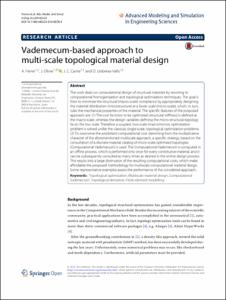Mostra el registre d'ítem simple
Vademecum-based approach to multi-scale topological material design
| dc.contributor.author | Ferrer Ferré, Àlex |
| dc.contributor.author | Oliver Olivella, Xavier |
| dc.contributor.author | Cante Terán, Juan Carlos |
| dc.contributor.author | Lloberas Valls, Oriol |
| dc.contributor.other | Universitat Politècnica de Catalunya. Departament de Física |
| dc.contributor.other | Universitat Politècnica de Catalunya. Departament d'Enginyeria Civil i Ambiental |
| dc.date.accessioned | 2016-08-26T12:00:23Z |
| dc.date.available | 2016-08-26T12:00:23Z |
| dc.date.issued | 2016-12 |
| dc.identifier.citation | Ferrer, A., Oliver, J., Cante, J.C., Lloberas, O. Vademecum-based approach to multi-scale topological material design. "Advanced modeling and simulation in engineering sciences", Desembre 2016, vol. 3, núm. 1, p. 1-22. |
| dc.identifier.issn | 2213-7467 |
| dc.identifier.uri | http://hdl.handle.net/2117/89387 |
| dc.description.abstract | The work deals on computational design of structural materials by resorting to computational homogenization and topological optimization techniques. The goal is then to minimize the structural (macro-scale) compliance by appropriately designing the material distribution (microstructure) at a lower scale (micro-scale), which, in turn, rules the mechanical properties of the material. The specific features of the proposed approach are: (1) The cost function to be optimized (structural stiffness) is defined at the macro-scale, whereas the design variables defining the micro-structural topology lie on the low scale. Therefore a coupled, two-scale (macro/micro), optimization problem is solved unlike the classical, single-scale, topological optimization problems. (2) To overcome the exorbitant computational cost stemming from the multiplicative character of the aforementioned multiscale approach, a specific strategy, based on the consultation of a discrete material catalog of micro-scale optimized topologies (Computational Vademecum) is used. The Computational Vademecum is computed in an offline process, which is performed only once for every constitutive-material, and it can be subsequently consulted as many times as desired in the online design process. This results into a large diminution of the resulting computational costs, which make affordable the proposed methodology for multiscale computational material design. Some representative examples assess the performance of the considered approach. |
| dc.format.extent | 22 p. |
| dc.language.iso | eng |
| dc.publisher | Springer |
| dc.rights.uri | http://creativecommons.org/licenses/by/3.0/es/ |
| dc.subject | Àrees temàtiques de la UPC::Enginyeria civil::Materials i estructures |
| dc.subject.lcsh | Multiscale modeling--Computer simulation |
| dc.subject.other | COMP-DES-MAT Project |
| dc.subject.other | COMPDESMAT Project |
| dc.subject.other | Topological optimization |
| dc.subject.other | Multiscale material design |
| dc.subject.other | Computational Vademecum |
| dc.subject.other | Topological derivative |
| dc.subject.other | Finite element modelling |
| dc.title | Vademecum-based approach to multi-scale topological material design |
| dc.type | Article |
| dc.subject.lemac | Modelització en etapes múltiples |
| dc.contributor.group | Universitat Politècnica de Catalunya. RMEE - Grup de Resistència de Materials i Estructures en l'Enginyeria |
| dc.identifier.doi | 10.1186/s40323-016-0078-4 |
| dc.description.peerreviewed | Peer Reviewed |
| dc.relation.publisherversion | http://link.springer.com/article/10.1186/s40323-016-0078-4 |
| dc.rights.access | Open Access |
| local.identifier.drac | 18819507 |
| dc.description.version | Postprint (published version) |
| dc.relation.projectid | info:eu-repo/grantAgreement/EC/FP7/320815/EU/Advanced tools for computational design of engineering materials/COMP-DES-MAT |
| local.citation.author | Ferrer, A.; Oliver, J.; Cante, J.C.; Lloberas, O. |
| local.citation.publicationName | Advanced modeling and simulation in engineering sciences |
| local.citation.volume | 3 |
| local.citation.number | 1 |
| local.citation.startingPage | 1 |
| local.citation.endingPage | 22 |
Fitxers d'aquest items
Aquest ítem apareix a les col·leccions següents
-
Articles de revista [2.209]
-
Articles de revista [3.018]
-
Articles de revista [125]


